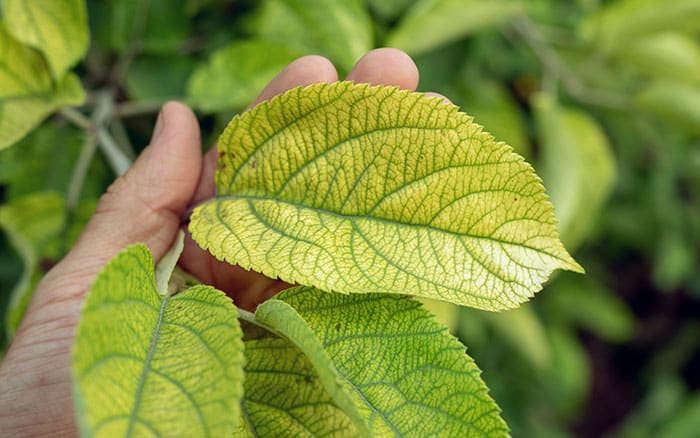Though plants may seem a bit of an enigma at times, there are some telltale signs that a plant might be in stress. Follow this guide to identify some common plant deficiencies which can be rectified with the right amount of TLC.
Nutrient needs
When it comes to nutrient-based deficiencies, these sometimes present in distinctive patterns on the foliage.
Iron
A lack of iron may show on a plant’s young leaves. They usually grow through as yellow in colour, which whitish tones, while the veins remain green by comparison. However, old or existing growth will appear normal.
Iron is essential for the maintenance of chloroplast structure and function. To get your plant back on track, you can actually add rusty nails or Brillo pads to the soil which will fix iron levels.

Nitrogen

This deficiency shows up mainly on the old growth, wilting the foliage and causing it to turn yellow. More often it will show much more on the lower leaves, with the upper leaves remaining light green, in most cases.
To balance nitrogen levels, you simply need to add some of your home composted soil—or you can buy nitrogen-rich compost at your local garden centre.
It’s important that plants have a ready supply of nitrogen as it is a vital component of their amino acids and energy processes.
Copper
Indications of lack of copper will present as leaf wilt and drop as well as pale pink in-between the leaf’s veins. Garden soils testing 2-100 ppm Cu should have an adequate supply, but if stocks are low you can use a fertiliser containing copper and add it into the soil.
As copper activates the plant’s the enzymes responsible for lignin synthesis, so you’ll find you’ll have happy and healthier plants once this is corrected.
Magnesium
If the tip of your leaves have yellowed, with this discolouration emanating inwards, it is a sign of a magnesium deficiency. The leaf’s vein most often stays dark as another indicator that this is what you’re dealing with.
Again, giving you plant some Epsom salts will help to right this imbalance, which is important because magnesium is a major building block of chlorophyll and leaves appearing green.

Phosphorus

If lower leaves have darkened, even turned purple, this is a sign that it’s lacking access to phosphorus. If left unchecked, this deficiency will move up the plant until the nutrient becomes available again.
You can buy bone meal fertilisers to add more levels into the soil, adequate supplies of phosphorous will help the plant in all of its energy processes.
Manganese
Manganese is responsible for biological systems such as photosynthesis and respiration. Not having enough levels of it in the soil will cause the plant to have yellow spots on the foliage and you may find that elongated holes appear in-between the veins.
Manganese is a major contributor to many plant biological systems. Simply add some manganese sulphate to the soil, which is available from most garden centres.

Potassium

Potassium shortage shows up as yellow patches which may die and purple pinholes. Younger growth may just have yellowing of the leaf edges.
Remedy by adding banana skins into the soil to give a plentiful supply of potassium—this maintains the plant’s water, nutrient and carbohydrate levels and processes.
Molybdenum
Plants may suffer from molybdenum defences when they’re in acidic soil. Though rare, if plants exhibit elongated twisted leaves it’s worth checking for.
Just add lime back into the soil for a long-term fix, especially crops most effected like brassicas and cauliflower. This will help maintain healthy long-term growth as this mineral is needed to assist in creating amino acids in the plant.
Calcium
Though old growth may not appear affected, with a calcium deficiency you get new growth appearing as misshapen, with curled or crinkled edging.
It’s important to keep calcium supplies in check because it plays a vital role in the plant’s growth and nutrition. It’s really easy to add calcium back in without spending a lot, just crush up your used eggshells and sprinkle these into the soil.

Zinc
Low zinc levels in a plant will show up as pale leaves, sometimes with dark spots and edging.
Remedy by putting some zinc sulphate or zinc oxide back into the soil. Zinc is vital in the plant’s formation of chlorophyll, so sufficient levels will help maintain healthy growth.
So, there you have it—a rundown of some plant symptoms and easy fixes to keep your garden growing efficiently.

Leave A Comment